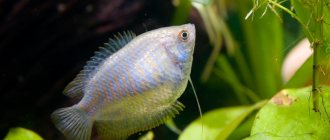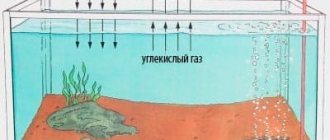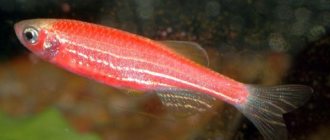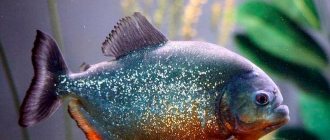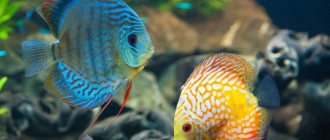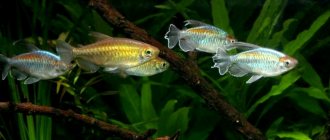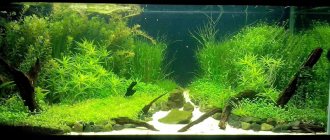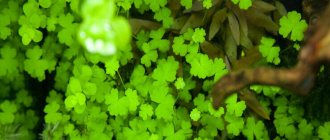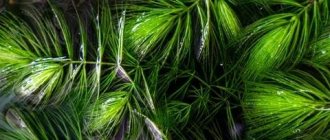Description
The body of the fish is high, slightly flattened on the sides and elongated in length. The head is large with a convex forehead, the eyes are larger than average, and the lips are thick. The dorsal and anal fins are pointed, the caudal fin is rounded. The color can be of various shades: from bluish-blue to reddish-burgundy.
Sizes vary depending on the species. Zebra, one of the smallest cancers, reaches 4-5 cm in length. Blue spotted and turquoise acara can grow up to 25 cm in aquarium conditions.
Males are more brightly and attractively colored. Usually in females there are only inclusions of various shades. The fins of males are longer and the body is larger. A characteristic feature of males is a noticeable fatty bump on the head, which appears already in adulthood.
Differences between the sexes in a pet
Acara breeds quietly in captivity. For success, the main requirement is to maintain the desired water characteristics in the tank. The fish mature at 8 months. Females lay eggs, and males fertilize them in the water.
We recommend reading
Which aquarium fish are the most unpretentious?
It is quite easy to distinguish between boys and girls. The gender differences are as follows.
Males:
- larger;
- they have brighter scales;
- they have a wide scarlet edging on their tail;
- they have bluish anal fins;
- there is a round fatty growth on the head on the forehead.
Females:
- have green anal fins;
- less colored;
- they do not have any growth on their forehead;
- they are more aggressive, and it shows.
Spawning is stimulated by increasing the water temperature by 1 or 2 degrees. The liquid is required with an acidity of 6.5. It should be soft or medium hard: 4-12°dH. Place several flat stones at the bottom of the vessel. The permissible spawning frequency is once every 3-4 weeks.
Akara in nature
The historical homeland of cancer is considered to be reservoirs located in the northwestern part of Peru and the Rio Esmeraldas River basin. They are also found in South America, Central Colombia, Brazil and some other countries, preferring bodies of water without strong currents with rich vegetation and multiple shelters.
Cancers have been kept in aquariums since the seventies of the last century, and today they are one of the most sought-after cichlids among fish lovers.
Content
Proper maintenance includes a clean living environment. You need to change the water in the aquarium at least once a week. Filtration and aeration are also necessary. Water should be changed at the rate of 20% of the volume of the entire aquarium. It is necessary to pour in fresh water very gradually, literally drop by drop. Otherwise, cichlids may get sick
.Akars need large amounts of water. Dwarf cichlids (such as the zebra) need to purchase an aquarium with a volume of at least 100 liters per couple, and large cichlids (such as the turquoise cichlid) will need a minimum of 200 liters for two. Then they will grow up to be healthy fish with bright colors. An insufficient aquarium size will lead to aggression even in peaceful cichlids.
But caring for cancer is not limited to this. The acidity and hardness of water is of great importance for them. Too low or high values lead to the death of fish. At the pet store you can buy special devices for measuring water parameters in an aquarium. Acidity and hardness must be checked daily. And be sure to measure the level of all parameters in fresh water when adding it to the aquarium.
There are various chemicals that help achieve the required values. But it is better to take care of your fish using natural methods. For example, some aquarium plants reduce water hardness (elodea, hornwort). It is also recommended to use filtered rainwater or melt water for the aquarium (after freezing it and then heating it to the desired temperature).
Cichlids are quite fastidious in caring for them. But they are also very picky about their tankmates. If you nevertheless decide to add fish compatible with them to the acara, this should be done only at the very early age of the cichlids.
Novice cachlid lovers may not know that these fish cannot be kept in the same aquarium with snails, as the cichlids will simply eat them.
Fish of this species love to dig in the ground, so stones with sharp corners cannot be used. Akara might get hurt. Be sure to create all kinds of shelters in the aquarium in the form of driftwood, broad-leaved plants, and mounds of stones. Cichlids need secluded places in their habitat.
Aquarium plants are best placed in the corners and along the back wall to give the fish more space to swim freely. Please note that large cichlids, digging in the ground, uproot plants, so it is necessary to secure them in separate containers.
House maintenance: water requirements
Acaras require a large aquarium, with a volume of more than 300 liters for two fish. If you add more inhabitants to the vessel, you will need a much larger aquarium.
To keep an aquarium, it is necessary to have an aerator and a powerful filter. The water must be clean, because cancers are large, they have a fast metabolism, and therefore a lot of waste. Replace 1/3 of the water every day. Under no circumstances should you change all the water at once, otherwise the fish will get sick.
Turquoise acara prefers soft and slightly acidic water with a temperature of 23-25 degrees. But fish can tolerate a decrease in temperature to 18 degrees, as well as water with average hardness and acidity. Optimal values: 7-8 pH, 13 dH. Significant changes in these characteristics lead to the disease and death of turquoise cancer.
We recommend reading
Important nuances of angelfish reproduction
To achieve the required softness, you can purchase plants that reduce hardness: elodea, hornwort. You can also take rainwater, place it in the freezer, then defrost it and pour it into a container. The permissible level for nitrates is 40.
Kinds
For a long time, all cancers were classified in the genus Aequidens, but due to too many differences in species, after the 1986 revision they were divided into 5 genera: bujurquina, cleytracara, guianacara, crobia, letacara.
As for the species, there are more than thirty of them: Peruvian, spotted, turquoise, red-breasted, blue, silver, black-striped and others, there is no point in listing them all. Let's look at a few of the most popular ones:
The bluish-spotted acara naturally lives in water bodies of Panama and Colombia, preferring those where the current is slow or absent. It appeared in Russia in 1910. Its body size in captivity does not exceed 6-8 cm. The fish is colored in grayish-brown tones. There are many spots: oblong dark ones across the body, black in the tail area, shiny bluish-green throughout the body. The fin on the back is dark blue with a red border. This species is peaceful and can be kept with other fish.
Acara Meri is common in South America and lives in the reservoirs of its northern part. In an aquarium it does not grow more than 12 cm in length. The body color is olive-silver with a dark back and a light belly. All fins are red, except for the dorsal one (it is sea green). The iris of the eyes is golden yellow. There is a dark stripe running from the eye to the tail. The entire body is decorated with shiny blue spots and strokes.
Acara Paraguayan lives in the very center of South America. This yellowish-brown fish can grow up to 12 cm. The entire body, including the fins, is covered with shiny green spots, and there are dark stripes on the sides. In small aquariums, Paraguayan acara become aggressive even towards their fellows.
Diseases and prevention
Acaras are fairly healthy fish with strong immunity. And all their diseases are associated with violation of maintenance conditions and incorrect water parameters. In this case, you may encounter the following pathologies:
- Ascitoma. To treat abdominal hydrops (bloating), antibiotics are needed, which are given along with the food, replacing most of the aquatic environment the next day. The use of Oxytetracycline, Chloramphenicol, Gentamicin, Baktopur helps well.
- Worm infestations. Most often they arise due to low-quality live food. To eliminate them, Metronidazole and Ciprofloxacin are dissolved in the liquid in calculated concentrations.
- Fungal infections. It is better to carefully remove the whitish coating and dead parts of the fins with tweezers, and place the pet in a bath with a weak solution of Malachite green. But the main thing with dermatomycosis is still prevention, which consists of regularly updating some of the water, aeration and high-quality filtration.
Diseases of Turquoise Acara are most often provoked by a stressful condition associated with its unfriendly nature, or poor quality care: non-compliance with living conditions, overeating or the use of poor food as food, in particular infected worms.
Let's look at the most common diseases of Turquoise Acara.
Spironucleosis
Hexamitosis or octomitosis. Caused by a parasite. The reason is a violation of the feeding regime, including overfeeding with food with a high protein content, or excessive pollution of the environment.
Symptoms:
- decreased appetite and body weight;
- privacy;
- bloating;
- darkening of scales;
- frequent mucus discharge;
- destruction of fins;
- ulcers or abscesses on the head: characteristic of a more advanced form of the disease.
Metronidazole, Tetracycline, Furazolidone, Kanamycin are used.
Abdominal dropsy. Reasons include: poor quality food, violation of living conditions, prolonged stress, old age.
Signs:
- bloated stomach;
- ruffled scales;
- bulging eyes;
- inactivity.
Can be fatal.
At an early stage, antibiotics are used: Oxytetracycline, Chloramphenicol or SERA Baktopur Direct, the dosages of which are determined by the size of the specimens, or Gentamicin - added daily to water - 20 mg per 1 liter.
Saprolegniosis
Dermatomycosis. Occurs when affected by a fungal infection.
Symptoms:
- white spots all over the body;
- possible gluing, shortening or destruction of fins;
- refusal of food;
- inactivity, even to the point of lying on the substrate;
- the eyes become cloudy, and a cataract is likely to occur.
Possible death.
Salt baths are used by immersing sick specimens in them for 5 minutes or cauterizing them with a manganese solution at the rate of 1 g per 1 liter of water throughout the entire body, except for the gills.
Prevention: systematic water changes.
Most often, cancer diseases are associated with the environment.
In an aquarium with these fish, you need to ensure the cleanliness of the aquatic environment. Dirty and stagnant water can become a good environment for the development of pathogenic bacteria (which can cause ascites) and fungi (which cause dermatomycosis).
If ascites is detected in the fish, oxytetracycline, chloramphenicol or other antibiotics should be given along with portions of food (the dose of the drugs is calculated according to the instructions). The next day after treatment, part of the water is replaced.
It is important to consider the compatibility of cancer with other aquarium inhabitants. Acaras are shy and susceptible. If in a common aquarium these fish huddle in a corner and stop eating, it is better to put them in another container.
Poor quality food can cause gastric diseases in these fish. Frozen foods are the most dangerous in this regard - the worms they contain can be carriers of infectious diseases. In case of diseases of the gastrointestinal tract (then the fish refuses to eat), antibacterial agents such as ciprofloctacin or metronidazole are dissolved in the aquarium water.
Feeding
Food should be ground beforehand, especially when feeding dwarf cichlids and all types of cichlids at an early age. Being micropredators, these fish grab food and swallow it whole. When feeding a whole tubifex or bloodworm, pieces of this food even stick out from the fish’s gills. After such a meal, the fish gets sick and dies. This type of fish should not be fed beyond measure, as they overeat and begin to get sick. It is best to give them small amounts of food once or twice a day. It is recommended to follow a feeding regime for cancer.
Large species of cichlids with age can already eat food entirely without harm to their health.
It is recommended to alternate different feeds. The optimal food for these cichlids is: hake, cod, navaga, pollock, pink salmon, squid, crab, octopus, live or frozen cyclops, bloodworms, brine shrimp, washed and chopped tubifex, daphnia, beef heart, beef liver, bell pepper, scalded lettuce, carrots, specialized dry food.
When feeding fish, do not overuse meat of animal origin. Heavy fat can negatively affect the condition of cancer.
When purchasing food for cancer, you should be careful. For example, you should not buy frozen bloodworms, since most often this product may be contaminated. It is better to purchase a fresh analogue, making sure that there are no contaminants on the worms.
Breeding
Acaras spawn in the same way as all cichlids. This can happen both in the spawning area and in the general reservoir.
The breeding season is characterized by aggressive behavior of fish.
It is not necessary to create any additional conditions. Sexual maturity in fish occurs at about one year.
Pairs are created easily. Caviar laying can be done on a stone, driftwood, or even just on a section of the bottom. This territory is pre-cleared by the fish. The female lays about 300-400 eggs and after they are fertilized by the male, she carries the eggs in her mouth until the fry appear (from 4 to 10 days).
The fry are fed with Cyclops, rotifers, ciliates and Artemia nauplii.
Compatibility
Under good conditions they are quite peaceful and calm.
The main reason for the aggression of these fish is an insufficiently spacious aquarium. When in close quarters, these cichlids tend to become bullying and provoke other fish into conflict.
Surprisingly, females are much more pugnacious than males, and this is especially evident during the spawning period, when they literally rush at everyone. To avoid fights, it is better to keep only one pair in the aquarium.
Chromis, severum, synodontis catfish, pterygoplicht catfish, and shark barb are quite suitable as neighbors for these fish. Not a very good combination with astronotus and Managuan cichlasoma. They can kill Akara in a fight.
It is also better not to add small African cichlids (angelfish) to them, which risk dying or living in constant stress next to these companions. Small fish, such as neons, guppies and others, are completely perceived as live food.
Mr. Tail recommends: variety of species
There are more than 30 varieties of Acara found in the aquarium hobby, although there are many more of them in nature.
Before the classification of Acars changed in 1986, they were all Equidens. But now new species have been identified:
We invite you to read: Description of the large Asher cat breed
- Bougerquins;
- Claytracars;
- Guianacara;
- Latracars;
- Crobia.
Turquoise Akara
One of the most famous and widespread species in the aquarium hobby. The fish are quite large and very beautiful. The main background is turquoise, the plumage has an orange border, but silver and metallic tints flash on the scales in the rays of light.
Turquoise Acara is the most charming and capricious inhabitant of the aquarium. Because of her eccentric nature, she is able to get along with few people, except perhaps the diamond cichlid, with which she is often confused. Indeed, the body of both fish seems to be sprinkled with diamond chips.
When properly maintained, Turquoise Acara behaves quite calmly; it loves slightly acidic and moderately hard water with a temperature of about 26 °C. Nevertheless, American breeders often call it the Green Terrorist.
Blue Acaras
The main background is soft blue on the body, a slightly brighter color on the plumage, decorated with a dark border. The eyes are large and reddish. The fatty lump in males is not as pronounced as in other types of cancer.
For a flock you need a fairly long artificial pond (preferably about a meter) with a slightly acidic water temperature of 24 °C.
Like all Akaras, Blue is curious, active and willful, but with the right selection of neighbors, her behavior can be controlled.
A peculiar variety of Blue. The main background of the scales is steel, with spots of heavenly color scattered across it and dark, almost purple transverse stripes running through it.
This breed has a calmer temperament compared to other varieties, but the correct selection of neighbors is required. During spawning they become overly aggressive.
This is a fairly small fish; in a home aquarium it grows only up to 8 cm.
Neon Acaras
Quite large fish with an original “metallic” color that fluoresces when light rays hit the scales.
The dorsal fin is very high and long, almost merging with the tail.
This fish has a calm character for Akar, which changes sharply during mating games.
They can get along with any neighbors who are not inferior to them in size.
Neon Nano Akara
These fish are also called Blue Electric for their unusual coloring - it is bright blue and sparkling, and in the rays of light it glows juicy orange. This reflection is especially visible at the ends of the luxurious plumage.
This is one of the most stunningly beautiful varieties of Acar.
Nano Akara is a rather difficult breed to breed, despite perhaps the calmest character for cichlids, and only experienced aquarists should try it. But the beauty of this sparkling miracle makes up for all the difficulties of care.
Red-breasted Akara
It is also a very expressive variety, despite the apparent simplicity of the color. The main background of the scales is silver-golden, and the lower part of the body has a pinkish tint.
The coloring of this Akara becomes especially bright during spawning. Usually the fish is very calm, but during mating games it claims a large territory and carefully guards it.
Akary Maroni
The color of this species contains many shades - reddish, yellowish, olive. There are also dark transverse stripes, especially noticeable on the head of the fish. In addition, each scale has a brown mark in the center.
The color changes during spawning, it becomes brighter. In addition, color greatly depends on your mood. Usually these fish are peaceful, even shy, and love to hide in algae and decorations. But during spawning they desperately protect the eggs and offspring.
The smallest of the Acaras, other than zebras, are a bit like bees. Wide black stripes run across the reddish-golden background.
These are very peaceful fish that do not show aggression even during the courtship and spawning period. Their sizes rarely exceed 5 cm.
Paraguayan Akara
Or Vittata, have a yellowish-brownish color with a bright green scattering of spots on the tail. The bodies are crossed by eight dark transverse stripes. The dorsal fin is emerald blue with a pink border.
These fish are normal micropredators, loving live food and raw meat, but to maintain the brightness of their color, their food must also contain carotenoids. The size of pets when kept in a home aquarium is 12-13 cm.
Acara Curviceps
Small fish that naturally live in the Amazon basin. The male is slightly larger and reaches 7-8 cm, females - about 5-6 cm.
The main body color is greenish-bluish, the plumage is luxurious, and there is a transverse pattern on the tail. The eggs are laid in a clay substrate (usually a special cone or flower pot is used).
Quite aggressive and pugnacious.
Found for the first time in Brazil, they grow up to 15-17 cm, reaching sexual maturity at a body length of about 8-9 cm.
Males are larger and brighter, with long anal and dorsal fins. The color is a mixture of blue, purple, gold, turquoise, and red. And the whole body shines in the rays of light, as if sprinkled with diamonds.
Acara Tetramerus
A very colorful South American fish found in river basins from Guyana to Rio de Janeiro.
They grow up to 15 cm (males are larger than females), sexually mature with a body size of about 9-10 cm.
The scales are bright, blue-yellow-red, the pectoral, anal and caudal fins are also reddish. Several large feathers protrude from the dorsal plumage directly above the head, like a perky crest.
Males are much brighter than females, and they are especially expressive during the mating season.
Akara Bujerkvina
These colorful and beautiful Acaras are a family that incubates eggs in the mouth. They have a large and foreheaded head, in males with a fatty bump.
Large eyes and thick lips are also characteristic of Bougerquins. Males are larger and brighter than females, and have long and pointed anal and dorsal fins.
Usually, by 7-8 months, pairs form in the flock, which then stay together all their lives. Quite large and strong individuals (up to 20-30 cm), actively digging the soil and digging up plants.
Grayish-olive fish with a dark longitudinal stripe along the flattened high sides. Rare sky-colored markings are scattered throughout the scales and plumage; they shimmer beautifully and play under the rays of light.
The dorsal and anal fins of males are copper-colored; the color becomes much brighter during the mating season.
In an artificial reservoir it reaches 12 cm, in natural conditions 20 cm. It belongs to the Bougerquina family, which incubates eggs in the mouth.
Acara is a very beautiful fish that attracts any aquarist, but you should not start the hobby for home artificial reservoirs with these species. This is a large and often aggressive pet that needs a lot of free space and a competent selection of neighbors. Of course, these are not the most capricious fish in terms of keeping conditions, but they need to be well understood and their character and habits studied.
The basic requirements for maintaining and caring for Akara at home are as follows:
- Spacious tank, long and wide. A pair of small (up to 10 cm) cancers need at least 100 liters of water.
- The purity of the liquid is very important; it should be carefully filtered (preferably with a powerful remote compressor) and replaced once a week with a fifth of the volume.
- The optimal living conditions for healthy keeping of pets are the following - temperature 20... 26 °C, low hardness up to 13 dH, neutral or slightly acidic environment 6.5-7.5 pH. It is better not to use chemicals, but to plant aquatic plants that soften the environment - elodea, hornwort. You can also use purified rainwater.
- It is preferable to use soft fractions as soil, on which Acaras cannot be injured, since these pets are avid diggers. For the same reason, the plants in the tank must have a strong and powerful root system, or they should be planted in an artificial pond in pots.
- Many Acara species, even most of them, despite their pugnacity, are shy and seek shelter. Therefore, you should decorate the aquarium with driftwood, stones, and grottoes with smooth walls and edges.
- They treat lighting calmly, daylight hours are about 12 hours, it is worth equipping the aquarium with a lid with fluorescent or LED lamps, under their rays the scales of Akar shine especially beautifully.
- Good air aeration and a water heating system are necessary.
Turquoise acara is a rather aggressive species of fish, especially females, which is why the condition for their comfortable keeping is the presence of sufficient personal space - aquariums with a volume of 100 liters per individual.
Landscaping of the tank must be done with non-living or unpretentious plants with strong rhizomes: echinodorus, Java fern, Java moss. Substrate: round stones of medium fraction (up to 10 mm in diameter).
We invite you to read: Diseases of decorative rabbits and their treatment 2019
Habitat indicators:
- temperature 23… 25 °C;
- acidity 6-8 pH, hardness 5-13 dGH;
- high-quality aeration, filtration;
- weekly water changes - at least 1/3 of the available volume;
- The lighting is average, daylight hours are up to 9 hours.
